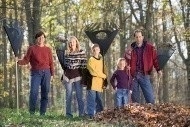 (MCT)—Ready to hunker down for winter?
(MCT)—Ready to hunker down for winter?
Not so fast.
Now’s the time to tackle a few chores that will help your house and yard ride out the cold season ahead. Here are a few to check off your to-do list.
Clean the Gutters
Gutters and downspouts direct rainwater away from your house. That keeps water from pooling around the foundation and leaking into the basement, or freezing in the gutters at the roof line and causing damaging ice dams.
But those gutters and downspouts can’t do their job if they’re clogged with leaves and other debris.
After the trees have finished shedding their leaves, get up on a ladder and clean that stuff out. Plug the top of the downspout with a rag first to keep debris from going down the spout, and wear heavy gloves to protect your hands.
Reader’s Digest Association’s “1,001 Do-It-Yourself Hints & Tips” recommends removing the debris with a plastic sand shovel or garden trowel, or you can fashion a scoop from a plastic milk jug. Dump the debris into a bucket instead of pushing it over the lip of the gutter to avoid dirtying the siding, the book suggests.
When the gutter is clean, run some water into it from a garden hose. Clear a clogged downspout with a plumber’s snake or a blast from the hose, working from the bottom up so you don’t compact the clog.
Clean Up the Garden
Even though plant growth winds down this time of year, diseases don’t necessarily go away. Many pests and pathogens spend the winter on diseased plant parts, lying in wait for the chance to launch a new attack in spring.
That’s why plant experts preach the importance of cleaning up diseased plant material. Prune out affected stems, remove diseased leaves and pick up any plant debris that’s lying around. Diseased annuals should be removed completely.
The affected plant material can be composted, but only if the pile gets hot enough to kill pathogens. Most home compost piles don’t get sufficiently hot, but municipal composting facilities do.
Fertilize Your Lawn
Lawn-care experts often say this is the best time to fertilize a lawn.
Fall fertilizing prepares grass plants for the rough winter ahead and ensures nutrients will be available to them in spring, when growth resumes.
Ohio State University’s Joe Rimelspach recommends two fall feedings, one around Labor Day and the other right about now. If you skipped that first fertilization, you won’t see the dramatic response in your lawn that you would have otherwise. (Your grass will still benefit from an application this time of year, he says, if you get some warm days.)
For an average lawn, he recommends applying a high-nitrogen lawn fertilizer at a rate of one to 1.5 pounds of nitrogen per 1,000 square feet. This late in the year, much or all of the nitrogen in the fertilizer should be water-soluble as opposed to slow-release, since the latter won’t release enough nitrogen before the weather gets too cold for growth. The percentage of soluble and slow-release nitrogen is usually marked on the fertilizer package.
Store Your Mower
You may be in the habit of adding fuel stabilizer to your lawn mower before you store it for winter, but that’s not enough, says Mark Stiles, owner of Bath Tractor.
Gasoline often contains ethanol, which pulls moisture from the air. If you leave the gas in the tank for an extended time, that moisture can cause metal to corrode, he said. In addition, the ethanol and water can settle to the bottom of the tank over time, causing engine problems and damage.
Gasoline shouldn’t be left in a lawn mower or other gas-powered equipment for more than two months, Stiles said. Before you store that equipment, run the engine until it’s out of gas, he advised.
It’s a good idea to clean your mower, sharpen the blade, change the oil, lubricate the engine and clean or replace the air filter, too, mower maker Lawn-Boy recommends.
Store the mower in a cool, dry place, Lawn-Boy says. If you cover it, use cloth, because plastic can trap moisture.
Inspect the Furnace
Experts differ on how often you need to have a heating system inspected and serviced. Dominion East Ohio and most heating contractors recommend annual maintenance, while the nonprofit American Council for an Energy Efficient Economy says every other year is sufficient for natural gas furnaces. The council recommends annual servicing for oil-fired systems.
A furnace inspection is a matter of safety as well as comfort. Besides spotting potential problems and helping your furnace run more efficiently, a technician can find combustion and venting issues that can lead to the production and buildup of deadly carbon monoxide.
Now’s the time of year to have your furnace inspected and possibly tuned up, before the weather turns bitter.
Dominion East Ohio recommends hiring a well-qualified contractor. The company says a thorough inspection should include:
—Lubricating the blower bearings and blower motor
—Inspecting all vents, the heat exchanger and the filters
—Checking the pilot light, if the furnace has one
—Clearing the furnace area of dust or combustible materials
—Cleaning dust from the blower compartment
—Testing the thermostat to be sure the heating system is working properly
—Checking the safety components
—Checking the flue to make sure it’s clean and open
Inspect the Chimney
Some people are motivated by saving money. Some are motivated by saving lives.
Either one should be an incentive to get your chimney inspected.
Chimney inspections help prevent both hazards and expensive repairs by spotting problems early, says Melissa Heeke, a spokesperson for the Chimney Safety Institute of America. The inspector looks for creosote buildup, cracks and obstructions such as birds’ nests and debris — problems that can contribute to chimney fires or carbon monoxide.
The institute recommends an annual inspection, Heeke says. It also recommends having the chimney cleaned when creosote builds up to thickness of one-eighth inch.
The inspection guideline goes for all exhaust flues, including flues for furnaces, gas water heaters and other devices that involve combustion, Heeke says. A flue inspection may or may not be part of a furnace inspection, so be sure to ask.
Most people need a basic chimney inspection, which involves a visual examination and check of accessible parts of the fireplace and chimney. The inspector will also look for obstructions and identify the type and extent of combustible deposits on the inside of the chimney.
Choose an inspector who’s certified by the CSIA, Heeke says. You can find one near you on its website, www.csia.org. She noted that only the individuals listed on the site are certified, not their companies.
Seal and Weatherstrip
Closing gaps in your home’s exterior and between conditioned and unconditioned areas keeps warm air in and cold air out. That not only makes you more comfortable, but it saves energy and money.
Some common problem spots are:
—The edges of doors, windows and chimneys
—Places where pipes or wires enter the house
—The joint between the foundation and the walls
—Baseboards, which often cover gaps between floor and wall
—Penetrations in the basement ceiling and attic floor for pipes, wires and ducts
Most small cracks and gaps can be sealed with paintable caulk, although chimneys and furnace flues require a specific type. For slightly bigger openings, use spray foam, being careful to choose the right kind for the job. Openings larger than about three inches across can be covered with foam board, sealed in place with caulk.
For doors and windows, which need to open, install weather-stripping and door sweeps.
While you can seal indoors anytime, take advantage of mild days to tackle work on the outside of your house. Caulk doesn’t stick well when the temperature drops below 50 degrees, and foam doesn’t flow well in the cold.
©2012 Akron Beacon Journal (Akron, Ohio)
Distributed by MCT Information Services










